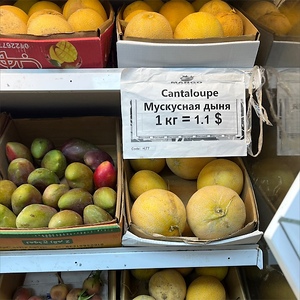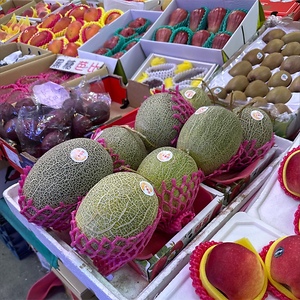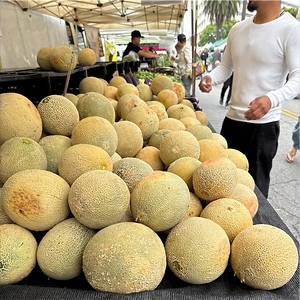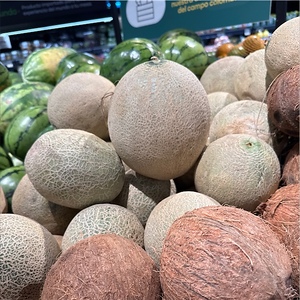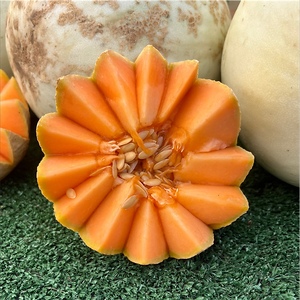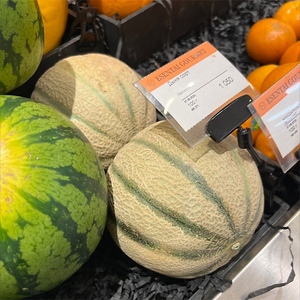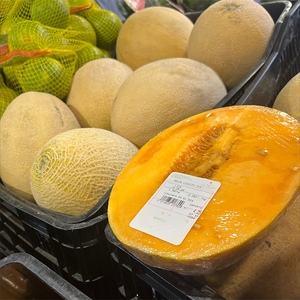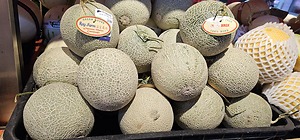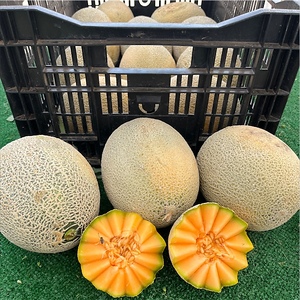

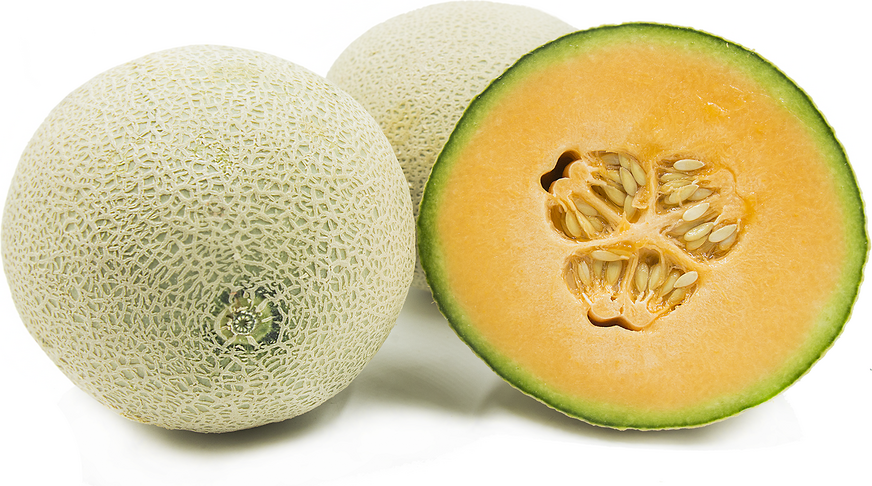
Cantaloupe Melons
Estimated Inventory, 36 lbs : 28.81
This item was last sold on : 07/14/25
Description/Taste
Cantaloupes are small to medium-sized melons, averaging 15 to 25 centimeters in length and 1 to 11 pounds, and have a round to oblong shape with blunt, curved ends. There are several types of melons generally labeled as Cantaloupes, some with beige-green, rough, firm, and warty to lightly ribbed skin, while other melons bear a pale beige-grey, netted or webbed exterior over a light green to tan, thin rind. Underneath the surface, the flesh is thick, dense, aqueous, and tender with a succulent, slightly sticky consistency. The flesh is mainly orange, but just below the rind, there is a fine green ring. There is also a central cavity filled with fibers and ivory, oval seeds encased in a light coating of gelatinous liquid. Cantaloupes have a honeyed, musky, and floral aroma when ripe and will feel heavy for their size, yielding slightly to pressure at the blossom end. The melon’s flesh has a distinct, sweet, floral, and fruity flavor and is primarily consumed as a fresh fruit. The seeds are also edible and are commonly roasted and salted as a savory, nutty snack.
Seasons/Availability
Cantaloupes have a peak season in the summer. The melons are also grown in both hemispheres for commercial export, providing a year-round supply for some markets.
Current Facts
Cantaloupes, botanically a part of the Cucumis genus, are aromatic melons belonging to the Cucurbitaceae family. There are two general categories of melons recognized under the Cantaloupe descriptor: European Cantaloupes, also known as True Cantaloupes, and North American Cantaloupes, or Common or Conventional Cantaloupes. European Cantaloupes are classified as Cucumis melo var. cantalupensis and are primarily grown in Europe and Asia. The melons have a hard, dense rind that showcases beige-green hues and is often covered in rough, wart-like protrusions. North American Cantaloupes, or Cucumis melo var. reticulatus, bear a light tan, netted rind, and are a type of muskmelon, valued for their thick orange flesh. Within each of these melon categories, there are many different varieties, and each cultivar thrives in various climates, soils, and growing conditions. Cantaloupes are favored for fresh eating and are sweet, aromatic melons with dense flesh. The melons are the most commercially cultivated and popular melon throughout the United States and are versatile in culinary preparations, well suited as a healthy snack, dessert topping, or accompaniment to sweet and savory dishes.
Nutritional Value
Cantaloupes are an excellent source of vitamin C to strengthen the immune system, vitamin A to maintain healthy organ functioning, and beta-carotene, the orange pigment found in the melon’s flesh that provides antioxidant-like properties to protect the cells from free radical damage. The melons also contain fiber to regulate the digestive tract, potassium to balance fluid levels within the body, and lower amounts of magnesium, vitamin B6, folate, niacin, and thiamine.
Applications
Cantaloupes have a sweet, juicy, and floral nature, showcased when served fresh. The melon’s rind should be scrubbed and washed with soap and water to remove harmful bacteria, and once cleaned, the melon can be sliced into wedges, cubes, and pieces. The seeds are also removed from the center cavity and can be cleaned, roasted, and dried as a crunchy snack. Cantaloupes can be incorporated into breakfast dishes such as oatmeal, cereal, ricotta cheese, or yogurt, served as a waffle or pancake topping, or consumed as a stand-alone dish. The flesh can also be pureed into smoothies and shakes, used as a flavor for cocktails, or blended into sorbet. In addition to sweet dishes, Cantaloupes can be tossed into green salads and fruit salads, wrapped in cured meats as an appetizer, or mixed into coconut broth as a chilled soup. The melons are not traditionally cooked, but some chefs simmer the melons with sugar to create a marmalade or lightly grill the surface for a rich, deep flavor. Cantaloupes pair well with herbs such as mint, basil, and cilantro, cheeses such as goat, feta, and ricotta, citrus, other fruits including kiwi, strawberries, honeydew, and watermelon, honey, vanilla, and nuts such as hazelnuts, almonds, and pistachios. Whole, unwashed Cantaloupes can be left at room temperature to ripen for up to three days. Once mature, the melons should be consumed immediately for the best quality and flavor. Cantaloupe slices can be stored in the refrigerator in a sealed container for three days.
Ethnic/Cultural Info
In Europe, Cantaloupes appear in a famous legend surrounding Pope Paul II. The pope lived on a summer estate in the country near the village of Cantalupo di Sabina during the 15th century. The folk tale recounts that Pope Paul II held office in the region from 1464 to 1471, and one night a group of Armenians met with Pope Paul II and offered him some Cantaloupe. The pope became enthralled with the exotic melon and began growing the fruits in his garden. The melons quickly became the pope’s favorite fruit, and he started excessively eating them from his garden. While the pope dined on Cantaloupes, in 1470, the pope’s chef, Bartolomeo Platina, published a cookbook titled De Honesta Voluptate Et Valetudine, which was the first cookbook to be printed on a press. The cookbook had a section on melons, which warned against eating melons by themselves or on a full stomach. In a twist of fate, Pope Paul II died from a heart attack the following year after eating two large melons. It is uncertain whether the melons were poisoned or if the pope suffered from indigestion. Much of this legend is disputed among experts in the modern-day, but the whimsical story is still shared around summertime dinner tables, as Cantaloupes are being served.
Geography/History
Cantaloupes are believed to be native to Persia and Western Asia and have been cultivated since ancient times. The melons were spread to North Africa, specifically Egypt, sometime before 2400 BCE and were also introduced to East Asia and Europe. Original Cantaloupes were smaller and not quite as sweet as modern cultivars, but over time, the melons were naturally bred to exhibit a uniform size, improved flavor, and disease resistance. Many varieties of Cantaloupes were also developed from commercial cultivation throughout Europe, the Middle East, and Asia. In 1494, Cantaloupes were brought to the New World with Christopher Columbus, and the seeds were traded to Native Americans who planted the melons as a food source. Cantaloupes later achieved commercial success in the New World in the 1880s and 1890s, when seed companies such as the W. Atlee Burpee Company introduced new and improved Cantaloupe cultivars, including Netted Gem, to growers in the United States. Netted Gem has remained a popular variety into the modern-day and was created from the Cantaloupe cultivars planted in North America by the Native Americans. Today Cantaloupes are cultivated worldwide and are produced for domestic consumption and export. China is the largest Cantaloupe producer, followed by India, Turkey, and Iran. Cantaloupes are also grown in the United States, with California and Arizona being the two main cultivation regions. When Cantaloupes are not in season in the United States, the melons are imported from countries in the Southern Hemisphere such as Costa Rica, Guatemala, Mexico, and Honduras. Cantaloupes are a common melon and are readily sold through local markets, distributors, and grocers.
Featured Restaurants
Restaurants currently purchasing this product as an ingredient for their menu.
| Cardellino | San Diego CA | 619-722-3398 |
| Campfire Bar | Carlsbad CA | 858-231-0862 |
| Rubicon Deli India Street | San Diego CA | 619-200-4201 |
| Brigantine Del Mar | Del Mar CA | 858-481-1166 |
| Oscars Brewing Company | Temecula CA | 619-695-2422 |
| Brockton Villa Restaurant | San Diego CA | 858-454-7393 |
| Green Dragon Tavern & Museum | Carlsbad CA | 760-797-5579 |
| Green Acres Campus | San Diego CA | 858-450-9907 |
| Maderas Golf Club | Poway CA | 858-451-8100 |
| Bread & Cie Café | San Diego CA | 619-683-9322 |
| Scion Health | Escondido California | 442-277-6167 |
| Brigantine Imperial Beach | Imperial Beach CA | 619-591-1350 |
| Craft House Sky Deck | San Diego CA | 619-948-4458 |
| Cafe 222 | San Diego CA | 619-236-9902 |
| Royal Polaris Sportfishing | San Diego CA | 619-226-8030 |
| Sheldons Service Station | La Mesa CA | 619-741-8577 |
| Brigantine Poway | Poway CA | 858-486-3066 |
| Marriott Del Mar | San Diego CA | 858-369-6029 |
| Sheraton Carlsbad (7 Mile) | Carlsbad CA | 760-827-2400 |
| Zanzibar at the Loft | La Jolla CA | 858-210-5476 |
| Viejas Casino Grove Steakhouse | Alpine CA | 800-295-3172 |
| Fay's Diner and Cafe | San Diego CA | 661-858-8895 |
| Vista Valley | Vista CA | 760-758-2800 |
| MCRD-Marine Corps Recruit Dept | San Diego CA | 619-725-6478 |
| Hotel La Jolla - Sea & Sky | La Jolla CA | 858-459-0261 |
| Gossip Grill | San Diego CA | 619-260-8023 |
| Vagabond Sportfishing Inc. | San Diego CA | 619-993-9575 |
| Saint Mark Golf and Resort, LLC | San Marcos CA | 508-320-6644 |
| Kona Kai Resort and Marina | San Diego CA | 619-221-8000 |
| Fox Point Farms (Haven) | Encinitas CA | 619-892-0553 |
| Olivewood Gardens and Learning Center | National City CA | 619-434-4281 |
| The Mission MB | San Diego CA | 858-488-9060 |
| Pendry SD (Lion Fish) | San Diego CA | 619-738-7000 |
| Lodge at Torrey Pines Main | San Diego CA | 858-453-4420 |
| Tahona (Bar) | San Diego CA | 619-573-0289 |
| Pacific Cafe & Catering (Medical Cntr Dr.) | La Jolla CA | 619-808-4087 |
| Cal A Vie | Vista CA | 760-945-2055 |
| Manna | Encinitas CA | 510-366-3057 |
| The Pearl Hotel (Brunch) | San Diego CA | 877-732-7573 |
| JRDN Restaurant | San Diego CA | 858-270-5736 |
| Huntress (Banquet) | San Diego CA | 619-955-5750 |
| Dot Cafe | San Diego CA | 914-263-1424 |
| Polaris Supreme | San Diego CA | 619-390-7890 |
| The Crosby Club | San Diego CA | 858-759-3852 |
| Bridges at Rancho Santa Fe | Rancho Santa Fe CA | 858-759-6063 |
| Lafayette Hotel - Quixote | San Diego CA | 619-296-2101 |
| Hilton Harbor Island | San Diego CA | 619-291-6700 |
| The Cottage La Jolla | La Jolla CA | 858-454-8408 |
| Marriott Courtyard Old Town | San Diego CA | 619-260-8500 |
| Jo's Mission Hills Diner | San Diego CA | 619-417-3801 |
| Coronado Yacht Club | Coronado CA | 619-435-1848 |
| Firefly Beach | San Diego CA | 619-222-6440 |
| Craft House Fashion Valley | San Diego CA | 619-948-4458 |
| Lauberge Del Mar | Del Mar CA | 858-259-1515 |
| Searcher Sportfishing | San Diego CA | 619-861-4640 |
| Candor | La Jolla CA | 858-581-2205 |
| Culinary Concepts | San Diego CA | 619-865-1918 |
| Portside Pier (TopSail) | San Diego CA | 858-268-1030 |
| Belching Beaver Brewery - Pub 980 | Vista CA | 760-420-7764 |
| Town & Country Main Storeroom | San Diego CA | 619-291-7131 |
| University Club | San Diego CA | 619-234-5200 |
| Rancho Santa Fe Golf Club | Rancho Santa Fe CA | 858-756-1582 |
| Bernardo Heights Country Club | San Diego CA | 858-487-4022 |
| Born & Raised | San Diego CA | 619-944-1631 |
| Mission Bay Beach Club | San Diego CA | 858-201-7551 |
| Parkhouse Eatery | San Diego CA | 619 295 7275 |
| Junkyard Sports Bar and Grill | Oceanside CA | 760-407-8500 |
| WaterBar | San Diego CA | 619-308-6500 |
| Nectarine Grove | Encinitas CA | 760-944-4525 |
| Nutmeg Bakery & Cafe 1 | San Diego CA | 858-405-2401 |
| The Farm Golf Club | Rancho Santa Fe CA | 858-756-5585 |
| Isola La Jolla | La Jolla CA | 858-412-5566 |
| Rustic Root | San Diego CA | 619-232-1747 |
| Catania La Jolla | La Jolla CA | 619-884-5350 |
| Portside Pier (Brigantine) | San Diego CA | 858-268-1030 |
| Brigantine La Mesa | La Mesa CA | 619-465-1935 |
| Cove House | La Jolla CA | 858-999-0034 |
| Brigantine Escondido | Escondido CA | 760-743-4718 |
| The Mission EV | San Diego CA | 619-232-7662 |
| Stone Brewing-Liberty Station | San Diego CA | 619-269-2100 |
| Salt & Whiskey | San Diego CA | 619-544-1886 |
| The Granger Hotel | San Diego CA | 619-559-7287 |
| Pali Wine Company | San Diego CA | 310-893-0038 |
| C 2 C | San Diego CA | 619-972-9345 |
| Fort Oak | San Diego CA | 619-795-6901 |
| Pacific Terrace Hotel | San Diego CA | 858-581-3500 |
| Portside Pier (Ketch Tasting Deck) | San Diego CA | 858-268-1030 |
| Embassy Suites Downtown | San Diego CA | 619-481-9349 |
| Pacifica Del Mar | Del Mar CA | 858-792-0505 |
| Brigantine Pt Loma | San Diego CA | 619-224-2871 |
| Sandbar Sports Grill | San Diego CA | 858-488-1274 |
| Ki's Kitchen Commissary | VISTA CA | 760-777-0700 |
| Hilton Garden Inn | San Diego CA | 858-720-9500 |
| Seneca | San Diego CA | 619-588-2411 |
| Sabor a Vida Café & Deli | Vista CA | 760-536-3331 |
| Sheraton Carlsbad (20/20) | Carlsbad CA | 760-827-2400 |
| US Grant Hotel Main | San Diego CA | 619-232-3121 |
| Pacific Regent La Jolla | San Diego CA | 858-597-8008 |
| Panama 66 (Bar) | San Diego CA | 619-702-6373 |
| Bayside Landing | San Diego CA | 858-270-9200 |
| KI's | Encinitas CA | 760-586-8289 |
| Monarch School | San Diego CA | 619-804-1766 |
| Miguel's Cocina Carlsbad | Carlsbad CA | 760-759-1843 |
| Lodge at Torrey Pines Grill | San Diego CA | 858-453-4420 |
| A & M catering | San Diego CA | 206-802-8320 |
| Surf Side Cuisine | San Diego CA | 619-507-0891 |
| Inn at Rancho Santa Fe (Banquet) | Rancho Santa Fe CA | 858-381-8289 |
| Berry Good Food Foundation | La Jolla CA | 619-666-1633 |
| La Valle Coastal Club | Rancho Santa Fe CA | 858-759-5473 |
| La Dona | San Diego CA | 858-352-8134 |
| Miguel's Old Town | San Diego CA | 619-298-9840 |
| Beach Terrance Inn | Carlsbad CA | 760-729-5951 |
| Mission Bay Yacht Club | San Diego CA | 858-488-0501 |
| Sheraton La Jolla | San Diego CA | 858-453-5500 |
| InterContinental Vistal Kitchen | San Diego CA | 619-501-9400 |
| Little Frenchie | Coronado CA | 619-522-6890 |
| Sensations Salud | San Diego CA | 619-933-3489 |
| Lafayette Hotel - Mississippi Kitchen | San Diego CA | 619-296-2101 |
| Coco Maya by Miss Bs | San Diego CA | 858-245-3780 |
| Third Corner Ocean Beach | San Diego CA | 619-223-2700 |
| Ridgeview Health Center | San Diego CA | 858-293-3950 |
| Fish Market Downtown | San Diego CA | 619-232-3474 |
| The Wild Thyme Company | San Diego CA | 858-527-0226 |
| US Grant Hotel Grill | San Diego CA | 619-232-3121 |
| Continental Catering Inc | La Mesa CA | 907-738-9264 |
| Venissimo Cheese Hillcrest | San Diego CA | 619-491-0708 |
| Cloak and Petal Bar | San Diego CA | 619-501-5505 |
| Jennings House | San Diego CA | 858-349-6662 |
| Public House 131 | San Diego CA | 858-537-0890 |
| Park Hyatt Aviara (Ember & Rye) | Carlsbad CA | 760-448-1234 |
| Flap Your Jacks | San Diego CA | 858-224-7442 |
| The Corner Drafthouse | San Diego CA | 619-255-2631 |
| Dot to Dot Academy | San Diego CA | 858-485-1978 |
| Great Maple Hillcrest | San Diego CA | 619-255-2282 |
| The Country Club Of Rancho Bernardo | San Diego CA | 858-487-1134 |
| Ketch Grill and Taps | San Diego CA | 858-268-1030 |
| UCSD Food & Nutrition Department La Jolla | San Diego CA | 858-761-1269 |
| Venissimo Cheese Del Mar | Del Mar CA | 858-847-9616 |
| UCSD Health East campus | San Diego CA | 619-578-3373 |
| The Local-Pacific Beach | San Diego CA | 858-263-7475 |
| Burning Beard | El Cajon CA | 619-884-4716 |
| Miguel's Cocina Coronado | Coronado CA | 619-437-4237 |
| Carte Hotel | San Diego CA | 619-365-1858 |
| Sheraton Carlsbad (Distribution Center) | Carlsbad CA | 760-827-2400 |
| Shootz Fish X Beer (Carlsbad) | Carlsbad CA | 760-450-8070 |
| AC Hotel by Marriott SD | San Diego CA | 248-703-3310 |
| Hilton Garden Inn - Homewood Suites San Diego | San Diego CA | 619-696-6300 |
| Toast Cafe | San Diego CA | 858-208-9422 |
| Reata Glen | Ladera Ranch CA | 949-545-2250 |
| La Jolla Beach & Tennis Club | San Diego CA | 619-816-8319 |
| Urban Kitchen Catering | San Diego CA | 619-276-8803 |
| Bahia Resort Hotel | San Diego CA | 858-488-0551 |
| Estancia Adobe | San Diego CA | 858-550-1000 |
| Fernside | San Diego CA | 619-398-5156 |
| Isola Pizza Bar | San Diego CA | 619-564-2938 |
| UCSD Food & Nutrition Department Hillcrest | San Diego CA | 619-380-9840 |
| La Jolla Country Club | San Diego CA | 858-454-9601 |
| Cape Rey Carlsbad, a Hilton Resort | Carlsbad CA | 760-602-0800 |
| Casa | San Diego CA | 619-581-3003 |
| Chef Danielle Sharesse | San Diego CA | 619-892-2178 |
| Pendry SD (Pool House) | San Diego CA | 619-738-7000 |
| Pendry SD (Pastry) | San Diego CA | 619-738-7000 |
| Glenbrook Health Center | Carlsbad CA | 760-704-1000 |
| Brigantine Escondido Bar | Escondido CA | 760-743-4718 |
| Tartine | Coronado CA | 619-435-4323 |
| Spirit of Adventure Sportfishing | San Diego CA | 619-454-9711 |
| Campfire | Carlsbad CA | 760-637-5121 |
| Pacific Yacht Agents | Los Angeles CA | 808-214-0970 |
| Shoreside Support Boat | San Diego CA | 704-277-7929 |
| The Flavor Chef (Catering) | Vista CA | 619-295-3172 |
| Milton's Delicatessen, Grill & Bakery | Del Mar CA | 858-792-2225 |
| San Diego Yacht Club | San Diego CA | 619-758-6334 |
| Giuseppe Restaurants & Fine Catering | San Diego CA | 619-436-7006 |
| Brigantine Coronado | Coronado CA | 619-435-4166 |
| The Santaluz Club Inc - Banquet | San Diego CA | 858-759-3150 |
| Red Tail Catering | San Marcos CA | 858-605-8219 |
| Culinary Kitchen Catering and Events | Coronado CA | 619-798-8477 |
| Coast Catering | Escondido CA | 619-295-3173 |
| The Shores | La Jolla CA | 858-459-8271 |
| Southwestern Yacht Club | San Diego CA | 619-222-0438 |
| Hotel Indigo | San Diego CA | 619-295-3172 |
| Marriott Courtyard - Broadway | San Diego CA | 619-446-3008 |
| Shogun Sportfishing | San Diego CA | 619-226-8030 |
| Pamplemousse Grill | Solana Beach CA | 858-792-9090 |
| Il Giardino di Lilli | La Jolla CA | 619-467-9897 |
| Humphrey's | San Diego CA | 619-224-3577 |
| Black Radish | San Diego CA | 619-775-7412 |
| Portside Pier (Miguels) | San Diego CA | 858-268-1030 |
| Aztec Shop Catering | San Diego CA | 619 594-3576 |
| Marriott Gaslamp | San Diego CA | 619-696-0234 x6051 |
| The Remy | San Diego CA | 619-886-1358 |
| Cody's La Jolla | La Jolla CA | 858-459-0040 |
| Peohes | Coronado CA | 619-437-4474 |
| Harvest Kitchen | Vista CA | 619-709-0938 |
| Belmont Park Draft | San Diego CA | 858-228-9283 |
| The Guild Hotel | San Diego CA | 619-764-5108 |
| Marriott Coronado | Coronado CA | 619-435-3000 x6335 |
| Tom Hams Light House | San Diego CA | 619-291-9110 |
| Miguel's Cocina Pt Loma | San Diego CA | 619-224-2401 |
| Mission Pacific | Oceanside CA | 760-450-7864 |
| Marriott Courtyard Nolen | San Diego CA | 619-544-1004 |
| Fairmont Grand Del Mar | San Diego CA | 858-314-1975 |
| Miguel's 4S Ranch | San Diego CA | 858-924-9200 |
| The Mission NP | San Diego CA | 619-220-8992 |
| Chateau La Jolla | San Diego CA | 858-459-4451 |
| Venissimo Cheese North Park | San Diego CA | 619-376-1834 |
| Crest Cafe | San Diego CA | 619-295-2510 |
| Blue Water Seafood Market and Grill | San Diego CA | 619-497-0914 |
| Del Mar Country Club | Rancho Santa Fe CA | 858-759-5995 |
| The Seabird Resort | Oceanside CA | 442-222-9505 |
| Harley Gray Kitchen and Bar | San Diego CA | 619-840-7000 |
| Sheraton Carlsbad (Banquets) | Carlsbad CA | 760-827-2400 |
| The Glen at Scripps Ranch | San Diego CA | 858-444-8500 |
| Hotel Republic San Diego | San Diego CA | 951-756-9357 |
| Jake's Del Mar | Del Mar CA | 858-755-2002 |
| Drift Cafe | San Diego CA | 858-263-4298 |
| Vitality Tap - 1St Ave | San Diego CA | 619-237-7625 |
Recipe Ideas
Recipes that include Cantaloupe Melons. One



